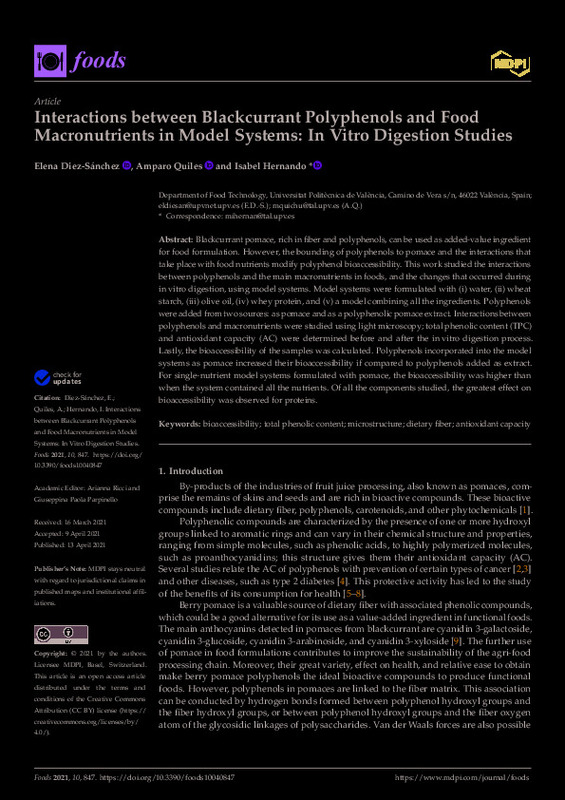JavaScript is disabled for your browser. Some features of this site may not work without it.
Buscar en RiuNet
Listar
Mi cuenta
Estadísticas
Ayuda RiuNet
Admin. UPV
Interactions Between Blackcurrant Polyphenols and Food Macronutrients in Model Systems: In Vitro Digestion Studies
Mostrar el registro sencillo del ítem
Ficheros en el ítem
| dc.contributor.author | Diez-Sánchez, Elena
|
es_ES |
| dc.contributor.author | Quiles Chuliá, Mª Desamparados
|
es_ES |
| dc.contributor.author | Hernando Hernando, Mª Isabel
|
es_ES |
| dc.date.accessioned | 2022-06-07T18:02:26Z | |
| dc.date.available | 2022-06-07T18:02:26Z | |
| dc.date.issued | 2021-04 | es_ES |
| dc.identifier.issn | 2304-8158 | es_ES |
| dc.identifier.uri | http://hdl.handle.net/10251/183112 | |
| dc.description.abstract | [EN] Blackcurrant pomace, rich in fiber and polyphenols, can be used as added-value ingredientfor food formulation. However, the bounding of polyphenols to pomace and the interactions thattake place with food nutrients modify polyphenol bioaccessibility. This work studied the interactionsbetween polyphenols and the main macronutrients in foods, and the changes that occurred duringin vitrodigestion, using model systems. Model systems were formulated with (i) water, (ii) wheatstarch, (iii) olive oil, (iv) whey protein, and (v) a model combining all the ingredients. Polyphenolswere added from two sources: as pomace and as a polyphenolic pomace extract. Interactions betweenpolyphenols and macronutrients were studied using light microscopy; total phenolic content (TPC)and antioxidant capacity (AC) were determined before and after thein vitrodigestion process.Lastly, the bioaccessibility of the samples was calculated. Polyphenols incorporated into the modelsystems as pomace increased their bioaccessibility if compared to polyphenols added as extract.For single-nutrient model systems formulated with pomace, the bioaccessibility was higher thanwhen the system contained all the nutrients. Of all the components studied, the greatest effect onbioaccessibility was observed for proteins. | es_ES |
| dc.description.sponsorship | This research was funded by Instituto Nacional de Investigación y Tecnología Agraria y Alimentaria (INIA-Spain) through the BERRYPOM. Adding value to processing waste: innovative ways to incorporate fibers from berry pomace in baked and extruded cereal-based foods project included in the ERA-NET-SUSFOOD program. | es_ES |
| dc.language | Inglés | es_ES |
| dc.publisher | MDPI AG | es_ES |
| dc.relation.ispartof | Foods | es_ES |
| dc.rights | Reconocimiento (by) | es_ES |
| dc.subject | Bioaccessibility | es_ES |
| dc.subject | Total phenolic content | es_ES |
| dc.subject | Microstructure | es_ES |
| dc.subject | Dietary fiber | es_ES |
| dc.subject | Antioxidant capacity | es_ES |
| dc.subject.classification | TECNOLOGIA DE ALIMENTOS | es_ES |
| dc.title | Interactions Between Blackcurrant Polyphenols and Food Macronutrients in Model Systems: In Vitro Digestion Studies | es_ES |
| dc.type | Artículo | es_ES |
| dc.identifier.doi | 10.3390/foods10040847 | es_ES |
| dc.relation.projectID | info:eu-repo/grantAgreement/EC/FP7/291766/EU | es_ES |
| dc.rights.accessRights | Abierto | es_ES |
| dc.contributor.affiliation | Universitat Politècnica de València. Departamento de Tecnología de Alimentos - Departament de Tecnologia d'Aliments | es_ES |
| dc.description.bibliographicCitation | Diez-Sánchez, E.; Quiles Chuliá, MD.; Hernando Hernando, MI. (2021). Interactions Between Blackcurrant Polyphenols and Food Macronutrients in Model Systems: In Vitro Digestion Studies. Foods. 10(4):1-14. https://doi.org/10.3390/foods10040847 | es_ES |
| dc.description.accrualMethod | S | es_ES |
| dc.relation.publisherversion | https://doi.org/10.3390/foods10040847 | es_ES |
| dc.description.upvformatpinicio | 1 | es_ES |
| dc.description.upvformatpfin | 14 | es_ES |
| dc.type.version | info:eu-repo/semantics/publishedVersion | es_ES |
| dc.description.volume | 10 | es_ES |
| dc.description.issue | 4 | es_ES |
| dc.identifier.pmid | 33924602 | es_ES |
| dc.identifier.pmcid | PMC8070145 | es_ES |
| dc.relation.pasarela | S\435603 | es_ES |
| dc.contributor.funder | European Commission | es_ES |
| dc.contributor.funder | Instituto Nacional de Investigación y Tecnología Agraria y Alimentaria | es_ES |








